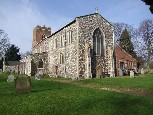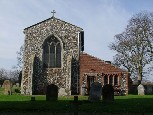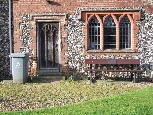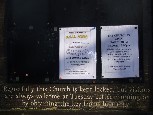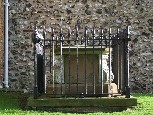| |
|
St Mary
and St Margaret, Sprowston, Norwich
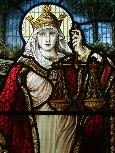 |
|
It
was a bright Saturday in January, and I had left
the centre of Norwich to follow a weaving path
out through the north-eastern suburbia, visiting
churches of various denominations with varying
degrees of sucess. By midday I had reached the
outer limits, the very edge of the city. I turned
off of Sprowston Road along the promisingly named
Church Lane, and after doglegging a bit around
the new road system I found myself cycling up the
side of a playing field towards the splendour of
a fine 18th Century red brick tower, which lifted
its handsome face above the modern housing and
the fields beyond. This big
church, the parish church of what is nowadays
Norwich's most populous suburb, was a beautiful
sight in the sunshine. It appears much bigger
than it actually is, partly because of the way
that the clerestory runs continually all the way
to the east end of the chancel, even though the
aisles stop short. It gives the illusion that the
chancel might be two-storey inside, which it
obviously isn't. The graveyard is well-kept, but
interesting too for its older stones. To the
north of the church I could see the new burial
ground, and local people in the sunshine tending
the graves of their loved ones. It was all very
pleasing - you really felt that they still saw
this old place as the heart of their community.
|
I had been
led to expect that I would find St Mary and St Margaret
open, and so I was at first a little disappointed when
the noticeboard told me that Regretfully this church
is kept locked, especially as the key at the Rectory
was way back at St Cuthbert. But then I saw another
notice above it saying that The Church is Open Daily,
which was much more encouraging. It turned out that the
noticeboard is about to be replaced, and all that is
necessary is the awaited planning permission. Looking
across at the porch, I could see that the outer door was
indeed wedged open, and so I trotted across
enthusiastically. As I walked, I looked again at that
imposing south side. It seems that much of it was
remodelled during the 1880s restoration at the hands of
Edward Boardman, an architect more often associated with
banks than churches.
I opened
the inner door, and stepped down inside. Well. all I can
say is that this church is one of the most welcoming that
I have visited in all Norfolk. Everything is intended to
extend a hand of friendship, and this is epitomised by
the open door into the kitchen and lavatory extension,
and a sign saying Dear visitor; you are welcome to
make a drink in the annexe kitchen. I thought that
was excellent, a model of what a church should offer, if
it can, to pilgrims and strangers.
Boardman's
restoration was not carried out with a light touch, but
in any case the church had been considerably restored in
the early 18th Century when the tower was rebuilt. The
big, clear windows of the south and north sides of the
nave fill it with a honeyed light, and the sheer height
of the nave and chancel creates a dramatic effect, not
lessened by the way the steps to the sanctuary lead up
towards Boardman's good east window with its glass by
Heaton, Butler & Bayne. The church is big enough not
to be dominated by its most significant survivals, which
are fine group of memorials to members of the Adams,
Corbets and Knoles familes in the north aisle and
chancel. As at Old Catton a couple of miles off, they are
reminders of the power and importance of the big familes
on the edge of what was still England's third largest
city until well into the early modern period. Most moving
are the figures of grief standing either side of the
memorial to Thomas Adams and his wife. Adams, who died in
the early years of the Restoration, had been Lord Mayor
of London before the Commonwealth. The weeping putti
rather put the characterless reclining figures of Adams
and his wife in the shade. More alarming are the figures
of Thomas Corbet and his wife, like coloured dummies who
have escaped from Madame Tussaud's, and are now lying low
in the country. Thomas Adams bought the Sprowston estate
from Thomas Corbet's son in 1645, thus transferring it
from one dynasty to another.
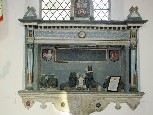 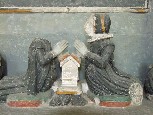 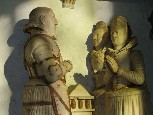
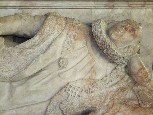 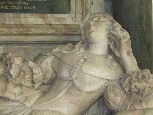 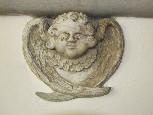
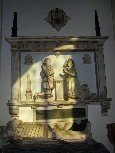 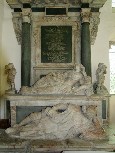 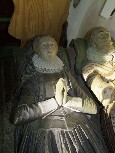 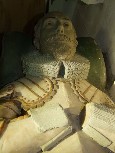
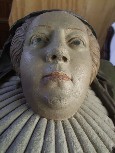 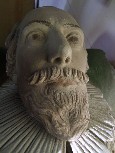 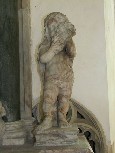 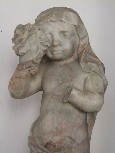
I have
already mentioned the Heaton, Butler & Bayne glass in
the east window, which depicts the Acts of Mercy - the
same subject can be found a short distance across the
suburbs at Old Catton, so must have been much in the mind
of late 19th Century north Norvicians. Also very good are
Jones & Willis's figures of Justice and Mercy in the
south aisle, full of early 20th Century piety and
triumph. From later in that century is the delightful
memorial window to Dorothy Mary Furze, also in the south
aisle. It depicts the symbol of St Dorothy and the figure
of St Mary Magdalene, and I think it must be the work of
the King workshop.
| I
visit a lot of churches, as you may imagine, and
there are some places where you get a sense of
the marginalisation of organised religion in
general, and of the Church of England in
particular. Nothing could be further from the
truth at St Mary and St Margaret. The welcome for
visitors, the war memorial, the various banners,
the family history records at the back of the
church, all of these things contribute to the
feel of a place which is at the heart of its
community, and a touchstone. It
delighted me that the people I had seen outside
laying flowers on graves could, if they wanted
to, combine their visit with a prayer said in a
church. Where a church is kept locked, this is
not possible, and grave-tending becomes a pagan
act, divorced from the reality that the Church is
there to minister to both the grief of the living
and the journey of the dead. Because of open,
welcoming churches like St Mary and St Margaret,
this will not be forgotten in Sprowston as easily
as it might be in some places.
|
|
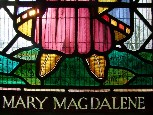 |
|
|
|

